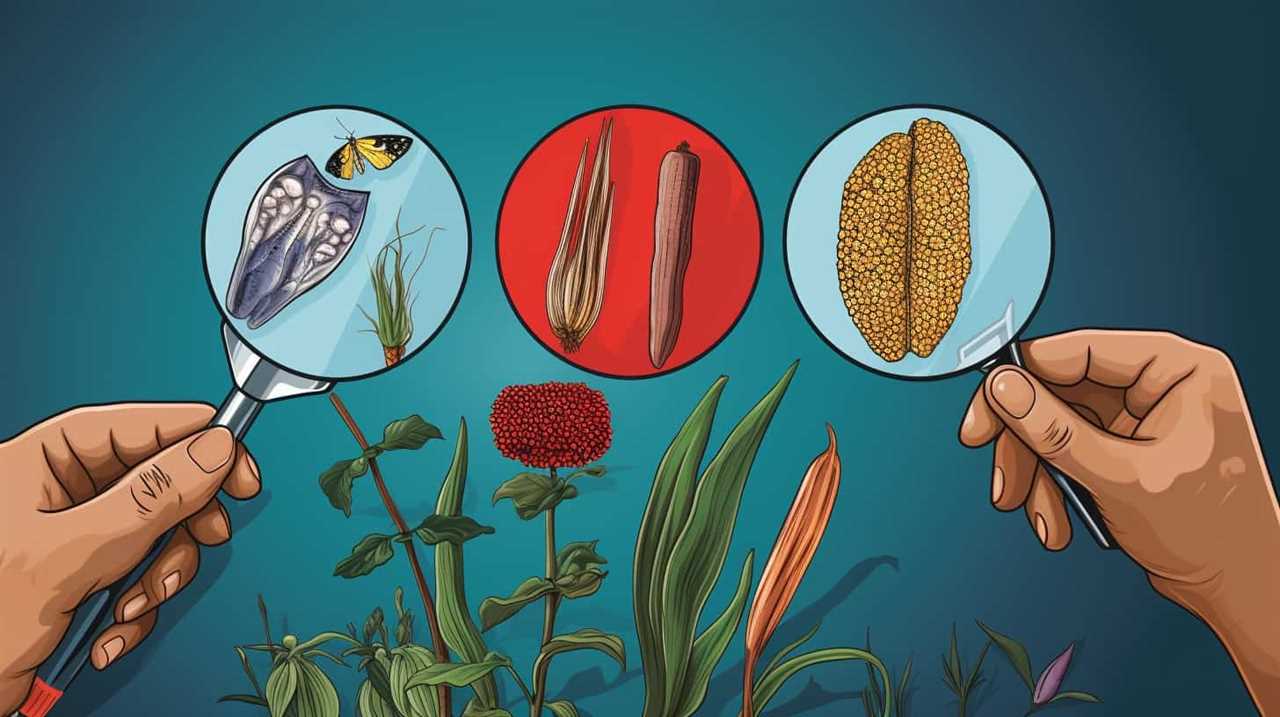
Curious about potential allergic reactions to chia seeds? Look no further for information and help!
In this article, we’ll delve into the various symptoms and risks associated with chia seed allergies. From skin reactions to respiratory and gastrointestinal issues, we’ll cover it all.
Pay close attention to the cardiovascular symptoms and the potential risk of anaphylaxis.
Stay informed and empowered as we guide you in identifying and understanding allergic reactions to chia seeds.

Key Takeaways
- Itchy rashes and hives are common skin reactions to chia seed allergies.
- Difficulty breathing is a common respiratory symptom of chia seed allergies.
- Diarrhea can be triggered by chia seed allergies, leading to frequent bowel movements and dehydration.
- Chia seed allergies can manifest as heart palpitations, indicating a rapid or irregular heartbeat.
Skin Reactions
We will now discuss the skin reactions that can occur as a result of allergic responses to chia seeds.
Allergic reactions to chia seeds can manifest in various ways, with itchy rashes and hives being common skin reactions.
When individuals with a chia seed allergy come into contact with chia seeds or products containing chia seeds, their immune system may perceive them as harmful substances and trigger an allergic response.
This immune response can lead to the release of histamines, which causes blood vessels to dilate and results in itchy rashes and hives on the skin.

Itchy rashes are characterized by red, inflamed patches that may be accompanied by intense itching. Hives, on the other hand, appear as raised, itchy bumps on the skin.
If you experience these skin reactions after consuming or coming into contact with chia seeds, it’s important to seek medical attention for proper diagnosis and management.
Respiratory Symptoms
One common respiratory symptom of allergic reactions to chia seeds is difficulty breathing. When individuals with chia seed allergies are exposed to chia seeds, their airways can become inflamed, leading to a sensation of tightness in the chest and a feeling as if they can’t get enough air. This can result in wheezing, a high-pitched whistling sound that occurs during breathing due to narrowed air passages.
In addition, nasal congestion may also occur, making it difficult to breathe through the nose. These respiratory symptoms can be distressing and may require immediate medical attention. Understanding and recognizing these symptoms is crucial in order to promptly address allergic reactions and prevent any potential complications.

Transitioning to the subsequent section, gastrointestinal issues can also arise as a result of chia seed allergies.
Gastrointestinal Issues
Experiencing gastrointestinal issues is a common manifestation of allergic reactions to chia seeds. When it comes to the digestive system, allergic reactions can cause a range of uncomfortable symptoms. Here are four important points to consider:
-
Diarrhea: Allergic reactions to chia seeds can trigger loose, watery stools, leading to frequent bowel movements and dehydration.
-
Bloating: Many individuals may experience bloating as a result of chia seed allergies. This uncomfortable sensation can be accompanied by abdominal discomfort and distention.

-
Abdominal pain: Allergic reactions may cause abdominal pain, which can range from mild discomfort to severe cramping.
-
Nausea and vomiting: Some individuals may experience these symptoms as a result of chia seed allergies. It’s important to monitor for signs of dehydration and seek medical attention if these symptoms persist.
If you or someone you know is experiencing these gastrointestinal issues after consuming chia seeds, it’s recommended to consult a healthcare professional for proper diagnosis and guidance.
Cardiovascular Symptoms
Another important aspect of allergic reactions to chia seeds is the presence of cardiovascular symptoms. These symptoms can range from mild to severe and may include heart palpitations and high blood pressure.

Heart palpitations, also known as rapid or irregular heartbeat, can be a sign of an allergic reaction to chia seeds. They may occur due to the release of histamine, a chemical that triggers inflammation and allergic responses.
Additionally, high blood pressure can be a result of an allergic reaction, as the body’s immune system reacts to the allergens present in chia seeds.
It’s crucial to monitor these cardiovascular symptoms closely and seek medical attention if they persist or worsen. Understanding and recognizing these symptoms can help individuals with chia seed allergies manage their condition effectively and prevent any potential complications.
Anaphylaxis Risk
As we continue discussing the allergic reactions to chia seeds, it’s important to address the anaphylaxis risk associated with consuming these seeds. Anaphylactic shock is a severe allergic reaction that can be life-threatening and requires immediate medical attention.

Here are four important points to consider regarding the anaphylaxis risk of chia seeds:
- Chia seeds can trigger anaphylactic reactions in individuals who are allergic to them.
- Symptoms of anaphylaxis may include difficulty breathing, swelling of the face or throat, hives, and a rapid heartbeat.
- If someone experiences anaphylaxis after consuming chia seeds, emergency treatment should be sought immediately.
- The emergency treatment for anaphylaxis often involves the administration of epinephrine, a medication that helps to reverse the allergic reaction and stabilize the person’s condition.
It is crucial to be aware of the anaphylaxis risk associated with chia seeds and to seek prompt medical attention if any symptoms of an allergic reaction occur.
Frequently Asked Questions
Can Chia Seeds Cause Allergic Reactions in People Who Have No Known Allergies?
Chia seeds can potentially trigger allergic reactions even in individuals without known allergies. Possible underlying factors and the role of genetics are important in determining susceptibility to chia seed allergies.
Are There Any Specific Age Groups More Prone to Experiencing Allergic Reactions to Chia Seeds?
Specific risk factors for allergic reactions to chia seeds include genetic predisposition and previous allergies. All age groups can be prone to experiencing these reactions, which can significantly impact the quality of life.

How Long Does It Typically Take for an Allergic Reaction to Chia Seeds to Occur After Consumption?
Onset time for allergic reactions to chia seeds varies, but symptoms typically appear within a few hours of consumption. These can include hives, itching, swelling, difficulty breathing, and digestive issues.
Can Allergic Reactions to Chia Seeds Worsen Over Time With Repeated Exposure?
Yes, allergic reactions to chia seeds can worsen over time with repeated exposure. This occurs as the immune system perceives chia seeds as a threat and mounts a stronger response. Underlying allergies may also contribute to the worsening of symptoms.
Are There Any Cross-Reactions Between Chia Seeds and Other Common Allergens, Such as Nuts or Seeds?
Yes, there can be cross-reactions between chia seeds and tree nuts in individuals with no known allergies. It’s important to be aware of these potential allergens to ensure safe consumption.
Conclusion
In conclusion, it’s important to be aware of the potential allergic reactions that can occur from consuming chia seeds. Studies have shown that approximately 1-3% of the population may experience an allergic response to chia seeds, with skin reactions being the most common symptom.

While respiratory, gastrointestinal, and cardiovascular symptoms may also occur, it’s crucial to note that anaphylaxis, a severe and potentially life-threatening reaction, can occur in rare cases. Therefore, individuals with known allergies should exercise caution when consuming chia seeds.
















